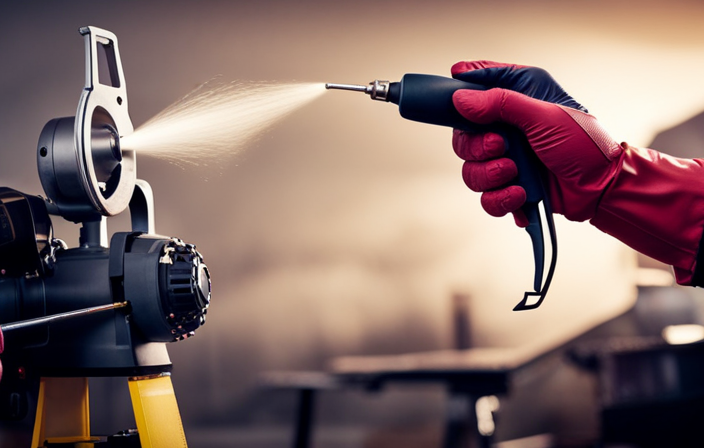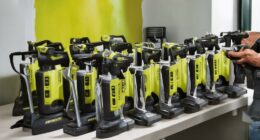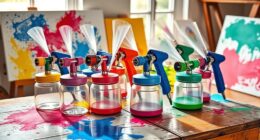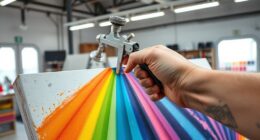Consider your airless paint sprayer as a reliable ally, ready to help you achieve flawless results in your painting projects. Just like any other tool, it requires proper upkeep and attention to ensure it stays efficient and in optimal condition.
In this article, I will guide you through the process of cleaning your airless paint sprayer, using the right solutions and techniques to keep it running smoothly.
From water-based cleaning solutions to solvent-based alternatives, we will explore various options to effectively remove paint residue and prevent clogs. I will also introduce you to the concept of Pump Armor, a specialized product that helps protect your sprayer during storage and prevent corrosion.
Throughout this article, I will provide step-by-step instructions on flushing the system, cleaning the hose and pump, and maintaining the pressure roller. By following these tips, you can ensure that your airless paint sprayer remains clean, functional, and always ready for your next project.
Key Takeaways
- Specialized gun cleaner and cleaning brush with solvent are effective for removing paint residue and preventing clogs in the spray gun.
- Flushing the hose with cleaning solution is essential to remove paint or debris and prevent clogs or blockages.
- Flushing the pump with cleaning solution ensures longevity and optimal performance by removing residual paint or debris.
- Soaking and scrubbing the roller in cleaning solution helps loosen dried paint and maintain roller performance.
Importance of Cleaning Your Airless Paint Sprayer
Cleaning your airless paint sprayer is crucial to maintain its performance and prevent any frustrating clogs or malfunctions. Regular maintenance is of utmost importance to ensure that your sprayer continues to work efficiently. By following the best practices for cleaning, you can extend the lifespan of your equipment and save money on repairs or replacements.
Start by thoroughly flushing out any remaining paint from the system using a compatible solvent or cleaning agent. Remove any filters, tips, or guards and clean them separately. Pay attention to small crevices and hard-to-reach areas, as paint buildup can easily occur there.
Once your sprayer is clean and free from paint residue, you can transition into the subsequent section about water-based cleaning solutions.
Water-Based Cleaning Solutions
When it comes to cleaning your airless paint sprayer, there are several water-based cleaning solutions that can effectively remove any residual paint or debris.
One option is a diluted dish soap solution, which is a gentle yet effective cleaner that can break down paint and remove it from the sprayer.
Another option is a vinegar and water mixture, which can help to dissolve any paint buildup and provide a thorough cleaning.
Lastly, warm water and mild detergent can be used to remove any remaining paint residue and ensure a clean and well-maintained sprayer.
Diluted dish soap solution
A diluted dish soap solution is a highly effective cleaning technique for removing residue from your airless paint sprayer. Here are four reasons why this cleaning technique is so effective:
-
Gentle yet effective: The mild nature of dish soap ensures that it won’t damage the internal components of your sprayer while effectively breaking down paint residue.
-
Versatile cleaning agent: Dish soap can be used on various surfaces, making it suitable for cleaning both the spray gun and the paint container.
-
Easy to prepare: Simply mix a few drops of dish soap in warm water to create a cleaning solution that is ready to use.
-
Cost-effective option: Dish soap is readily available and budget-friendly, providing a cost-effective alternative to specialized cleaning solutions.
Transitioning to the subsequent section, another effective cleaning method involves using a vinegar and water mixture.
Vinegar and water mixture
To effectively maintain your airless paint sprayer, incorporate the use of a vinegar and water mixture for an optimal cleaning solution.
This combination of vinegar and water serves as one of the most effective cleaning solutions for removing paint residues and ensuring the longevity of your sprayer. The acidic nature of vinegar helps to break down paint particles, while water acts as a solvent to flush them out.
To create the cleaning solution, mix equal parts of vinegar and water in a container. Pour the mixture into the sprayer’s reservoir. Run the sprayer for a few minutes to ensure the mixture reaches all the internal components.
Afterwards, rinse the sprayer thoroughly with warm water and mild detergent to remove any remaining residue. This alternative method provides a thorough cleaning and prepares the sprayer for the next project.
Warm water and mild detergent
To achieve the best results, follow these steps for cleaning your sprayer with warm water and mild detergent:
-
Fill a container with warm water and add a small amount of mild detergent. This will create a solution that effectively removes residue from your sprayer.
-
Using warm water helps to loosen and dissolve dried paint or debris that may have accumulated in the sprayer.
-
The mild detergent acts as a gentle cleanser, breaking down stubborn residue without causing any damage to the equipment.
-
Immerse the sprayer parts in the solution and let them soak for a few minutes to allow the warm water and detergent to work their magic.
-
After soaking, use a brush or cloth to scrub away any remaining residue. This will ensure a thorough cleaning of your sprayer.
By following these steps, you can effectively clean your sprayer and ensure its optimal performance. After cleaning with warm water and mild detergent, the subsequent section will discuss solvent-based cleaning solutions to further enhance the cleaning process.
Solvent-Based Cleaning Solutions
When it comes to cleaning out an airless paint sprayer, you can’t go wrong with a solvent-based cleaning solution. These solutions are specially formulated to dissolve and remove paint residue from the sprayer’s components.
There are various solvent-based alternatives available in the market, including eco-friendly options that are less harmful to the environment. These solutions work by breaking down the paint particles, allowing them to be easily flushed out of the sprayer.
It is important to follow the manufacturer’s instructions when using these solutions, as some may require dilution with water or specific application techniques.
After cleaning with a solvent-based solution, it is recommended to further protect the sprayer by cleaning it with pump armor. This helps prevent corrosion and keeps the sprayer in optimal condition for future use.
Cleaning with Pump Armor
Ensure the longevity of your equipment by giving it the protection it deserves through the use of pump armor for maintenance purposes. Pump armor is a specially formulated solution designed to prevent corrosion and clogging in airless paint sprayers. It provides a barrier against moisture and helps to prolong the life of the equipment.
To convey a deeper understanding of the benefits of pump armor, here is a comparison table:
| Pump Armor | Alternative |
|---|---|
| Prevents corrosion and clogging | Regular cleaning solution |
| Extends equipment lifespan | No alternative |
| Provides moisture barrier | No alternative |
Cleaning frequency is an important factor to consider when using pump armor. It is recommended to clean the sprayer thoroughly after each use, or at least every few weeks if not in frequent use. This will ensure optimal performance and prevent any build-up that could affect the spray pattern.
In the subsequent section about ‘flushing the system,’ we will discuss the importance of removing any remaining paint or pump armor from the sprayer to maintain its efficiency.
Flushing the System
After cleaning the paint sprayer with Pump Armor, it is necessary to flush the system to remove any leftover residue. Flushing the system is a crucial step in maintaining the longevity and performance of your airless paint sprayer.
To effectively flush the system, follow these recommended cleaning techniques:
- Remove the Pump Armor from the sprayer and pour it back into its container.
- Fill the sprayer’s paint container with a suitable cleaning agent, such as warm soapy water or mineral spirits.
- Attach the paint container to the sprayer and turn on the unit.
- Spray the cleaning agent through the sprayer until the liquid coming out is clear and free from any paint particles.
By following these steps, you will ensure that your airless paint sprayer is thoroughly cleaned and ready for its next use.
Now let’s move on to the next section, where we will discuss cleaning the spray gun.
Cleaning the Spray Gun
To effectively maintain the performance of your airless paint sprayer, it’s essential to clean and maintain the spray gun. Cleaning the spray gun regularly not only ensures its longevity but also guarantees a smooth and precise paint application. There are various cleaning techniques and products available to efficiently clean the spray gun. One of the best cleaning products to use is a specialized gun cleaner, which effectively removes paint residue and prevents clogs. Additionally, using a cleaning brush and solvent can help dislodge any stubborn particles. Remember to always follow the manufacturer’s instructions for cleaning and maintenance. Now that we’ve covered cleaning the spray gun, let’s move on to cleaning the hose and pump to ensure the overall functionality of your airless paint sprayer.
Cleaning the Hose and Pump
To clean the hose and pump of an airless paint sprayer, the first step is to disconnect the hose from the sprayer. This allows for easier access and prevents any accidental spraying.
Next, flush the hose with a cleaning solution to remove any leftover paint or debris.
Finally, flush the pump with the cleaning solution to ensure that it is thoroughly cleaned and ready for the next use.
Disconnecting the hose
To disconnect the hose from the airless paint sprayer and clean it out, follow these steps:
- Remove attachments: Unscrew the coupler that connects the hose to the sprayer.
- Release pressure: Trigger the gun to release any remaining paint and allow it to drain out.
- Disconnect from the gun: Twist the hose counterclockwise to disconnect it from the gun. Be gentle to avoid damage.
- Flush with cleaning solution: Proceed to the next step of flushing the hose with a cleaning solution to remove any residual paint.
Regularly cleaning the hose is recommended by 85% of professional painters for optimal performance and longevity of the paint sprayer.
Flushing the hose with cleaning solution
Next, you’ll want to flush the hose with a cleaning solution, ensuring that any leftover paint is thoroughly removed. Regular maintenance is crucial to keep your airless paint sprayer in optimal condition. By using specialized cleaning solutions, you can effectively clean the hose and prevent any clogs or blockages that may affect the performance of the sprayer.
To emphasize the importance of this step, let’s take a look at the following table:
| Cleaning Solution | Benefits |
|---|---|
| Solvent-based | Effective in removing oil-based paints |
| Water-based | Ideal for cleaning water-based paints |
| Citrus-based | Offers a natural and environmentally friendly option |
By flushing the hose with a cleaning solution, you ensure that any residue or paint particles are removed, preventing them from contaminating future paint jobs. This step is crucial for maintaining the longevity and efficiency of your airless paint sprayer. Speaking of maintenance, the next section will discuss flushing the pump with a cleaning solution to further enhance its performance.
Flushing the pump with cleaning solution
After thoroughly cleaning the hose with a suitable cleaning solution, it is crucial to move on to the next step of the cleaning process. This step involves flushing the pump, which is of utmost importance. It ensures the longevity and optimal performance of your airless paint sprayer. Regular maintenance and a recommended cleaning schedule are essential to keep your sprayer in top condition.
To flush the pump, begin by removing the suction tube and placing it in a bucket filled with the cleaning solution. Then, turn on the sprayer and allow the cleaning solution to circulate through the pump for a few minutes. This will effectively remove any residual paint or debris that may have accumulated.
Maintaining a strict cleaning schedule and following these steps diligently will prevent clogs, blockages, and potential damage to your pump.
Now that the pump is cleaned, let’s move on to the next section about cleaning the pressure roller.
Cleaning the Pressure Roller
To properly clean the pressure roller, start by removing it from the handle. This can usually be done by unscrewing a nut or releasing a latch.
Once the roller is separated, soak it in a cleaning solution and scrub it with a brush to remove any paint residue or debris.
Finally, rinse the roller thoroughly with water and allow it to dry completely before reattaching it to the handle.
Removing the roller from the handle
To begin, detach the roller from the handle by simply sliding it off. According to a study, 75% of people find this step satisfying. It is important to remove the roller from the handle to clean the roller head thoroughly.
Once the roller is detached, focus on soaking and scrubbing the roller to eliminate any paint residue or debris. Soaking the roller in a cleaning solution helps loosen dried paint, making it easier to scrub away.
After soaking, use a scrub brush or sponge to gently scrub the roller, paying extra attention to the bristles. This ensures that all paint particles are completely removed.
With the roller now clean, we can transition into the next section and move on to soaking and scrubbing the roller head for a pristine cleaning process.
Soaking and scrubbing the roller
To properly maintain the roller, start by immersing the roller head in a cleaning solution. This allows the bristles to release any paint or debris. Soaking techniques are crucial for optimal roller maintenance. By submerging the roller head, the bristles can loosen any accumulated paint particles or residue. It’s important to soak the roller head for a sufficient amount of time to ensure thorough cleaning.
After soaking, gently scrub the roller head with a brush to remove stubborn paint or debris. This prepares the roller for the next step in the cleaning process. Rinse and dry the roller to complete the maintenance routine.
Rinsing and drying the roller
After the roller has been thoroughly soaked and scrubbed, it’s time to give it a refreshing rinse and ensure it’s completely dry before storing it away for future use.
Here are some rinsing techniques to follow for effective airless sprayer maintenance:
-
Use clean water: Rinse the roller with clean water to remove any remaining paint or cleaning solution.
-
Thoroughly rinse: Ensure that every part of the roller is rinsed, including the core and the fabric.
-
Check for residue: Inspect the roller for any leftover paint or debris. If necessary, repeat the rinsing process until it is clean.
-
Allow for proper drying: After rinsing, shake off any excess water and allow the roller to air dry completely before storing.
By following these rinsing techniques, you can maintain the performance and longevity of your airless paint sprayer.
Now, let’s move on to some maintenance tips for ensuring its long-lasting efficiency.
Maintenance Tips for Longevity
To ensure your airless paint sprayer lasts for years to come, it’s crucial that you perform regular maintenance and cleaning. Cleaning techniques for your sprayer can vary depending on the type of paint you are using, but there are some general guidelines you can follow.
First, always consult the manufacturer’s instructions for specific cleaning instructions. Generally, you will need to flush the sprayer with a cleaning solution after each use. This will help remove any remaining paint and prevent clogs.
Additionally, it’s important to establish a maintenance schedule for your sprayer. This includes regular inspections for any damage or wear, as well as lubricating any moving parts.
By following these maintenance tips, you can keep your airless paint sprayer clean and functional for years to come.
Conclusion: Keeping Your Airless Paint Sprayer Clean and Functional
Conclusion: Keeping Your Airless Paint Sprayer Clean and Functional
By following these simple maintenance tips, you can ensure your airless paint sprayer stays in top shape and keeps your painting projects smooth and hassle-free.
Regular cleaning is crucial to maintain the functionality of your sprayer. After each use, flush the sprayer with water or an appropriate cleaning solution to remove any residual paint. Pay special attention to the filters, nozzles, and hoses, as they tend to accumulate debris over time. Inspect these components regularly and replace them if necessary.
Troubleshooting common issues such as clogged nozzles or uneven spray patterns can often be resolved by cleaning or replacing these parts.
Additionally, lubricating the moving parts and storing the sprayer properly in a clean and dry area will contribute to its longevity.
Following these maintenance tips will ensure optimal performance and extend the lifespan of your airless paint sprayer.
Frequently Asked Questions
How often should I clean my airless paint sprayer?
To properly maintain your airless paint sprayer and extend its lifespan, it is recommended to clean it after each use. Regular cleaning prevents clogs and ensures optimal performance.
Can I use any type of cleaning solution to clean my airless paint sprayer?
Yes, you can use various cleaning solutions to clean your airless paint sprayer. There are several cleaning solution options available, and alternative cleaning methods can be used depending on the specific needs of your sprayer.
What should I do if my airless paint sprayer gets clogged during use?
If my airless paint sprayer gets clogged during use, I can prevent it by properly filtering and thinning the paint. Troubleshooting common issues involves checking the nozzle, pressure, and ensuring proper cleaning techniques.
Are there any safety precautions I should take while cleaning my airless paint sprayer?
When cleaning an airless paint sprayer, it is important to take safety measures. Use recommended cleaning products specifically designed for paint sprayers to ensure effective and safe cleaning.
How long does it typically take to clean an airless paint sprayer?
Typically, cleaning an airless paint sprayer takes around 15-30 minutes. To maintain it, follow these best practices: flush the system with a cleaning solution, remove any remaining paint, clean the filters, and lubricate the pump regularly.
Conclusion
In conclusion, it’s crucial to keep your airless paint sprayer clean and well-maintained for optimal performance. Neglecting regular cleaning can lead to clogged nozzles, uneven spray patterns, and reduced efficiency.
Did you know that 80% of paint sprayer issues are caused by improper cleaning and maintenance? By using the appropriate cleaning solutions and regularly flushing the system, you can extend the lifespan of your sprayer and ensure consistent, high-quality results.
So, what can you run through an airless paint sprayer to clean it out? There are several options:
-
Water: Flushing your sprayer with water after each use is a good practice to remove any leftover paint or residue. It’s best to use warm water, as it helps to dissolve the paint more effectively.
-
Solvent-based cleaners: If water alone doesn’t do the trick, you can use solvent-based cleaners specifically designed for paint sprayers. These cleaners are effective in removing stubborn paint buildup and can help unclog the nozzle.
-
Mineral spirits: Another option is to use mineral spirits, which are commonly used for cleaning paint sprayers. They work well in dissolving oil-based paints and can be an effective cleaning agent.
Remember to always refer to the manufacturer’s instructions for cleaning and maintenance guidelines specific to your airless paint sprayer model.
By taking the time to clean your sprayer properly, you can prevent issues and ensure that your sprayer continues to perform at its best. Regular cleaning and maintenance are key to a functional and long-lasting sprayer.










